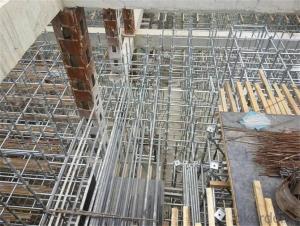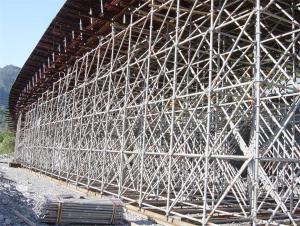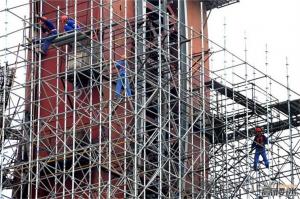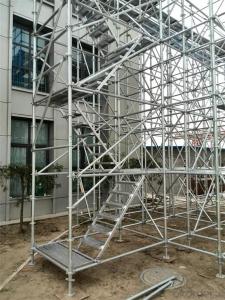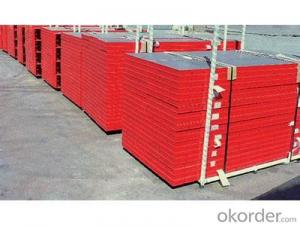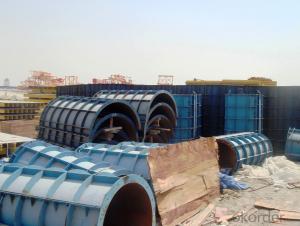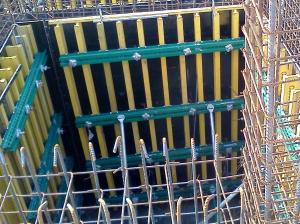RingLock Scaffolding with Cold Galvanized Surface Processing Style
- Loading Port:
- Shanghai
- Payment Terms:
- TT OR LC
- Min Order Qty:
- 1 m²
- Supply Capability:
- 100000 m²/month
OKorder Service Pledge
OKorder Financial Service
You Might Also Like
1.Structure of Ring lock Description
Ringlock Scaffolding system is the most popular used Scaffolding system in the world.It will greatly reduce the cost because of the following advantages
Packaging & Delivery
Packaging Details:
Pallet or bag or upon client's request
Delivery Detail:
35days
2.Main Features of Ringlock
It will greatly reduce the cost because of the following advantages
1)Using less pipes
2)Easy to install
3)It can be used again and again for nearly 20years
3.Ring lock product pictures:
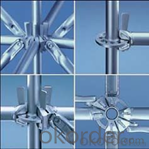
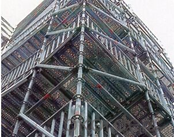
4.Ringlock Product Description
Type: ringlock scaffolding diagonal Brace
specification : Ø48.3×3.20
material:: steel Q235
Finished: Hot DIP galvanized, painted
Diagonal length(m) :Weight(kg)
0.9m * 1.25m 6.28
1.25m * 2.7m 11.45
5.FAQ
We have organized several common questions for our clients,may help you sincerely:
1)How about your company?
CNBM International Corporation, China National Building Materials (Group) Corporation, is one of the largest companies in China building material equipment industry, Our formwork and scaffolding are largely used in both domestic and all over world;
2)How many Scaffolding your company have?
Here comes our 5 types of Scaffolding systems:
- Cup lock Scaffolding(C-Lock Scaffolding)
- Ring lock Scaffolding
-Kwistage Scaffolding
-H-frame Scaffolding
-ID15 Scaffolding Tower, this type Scaffolding is the most widely used in construction, such like bridge.
3)How long can we receive the product after purchase?
Lead time is about 30days after getting the signed PI and deposit.
- Q:How does steel frame formwork prevent the formation of surface defects in the concrete?
- To ensure the smooth and accurate placement of concrete during construction, steel frame formwork plays a vital role in preventing surface defects. Firstly, it offers a stable and rigid structure that prevents any movement or shifting during pouring and curing. This stability allows the concrete to settle evenly, reducing the risk of cracks or unevenness. Secondly, the durability and resistance to deformation of steel frame formwork ensure it can withstand the pressure exerted by the concrete without bending or warping. This prevents any distortions that could lead to imperfections in the concrete. Additionally, the smooth and seamless design of steel frame formwork minimizes the chances of concrete leakage or seepage, which can cause honeycombing or voids. By containing the concrete effectively, it ensures a consistent and defect-free surface finish. Furthermore, steel frame formwork allows for precise control over the pouring process, easily adjusted and leveled for accurate placement and uniform thickness. This precision prevents unevenness or irregularities, resulting in a smoother and more aesthetically pleasing end product. In conclusion, steel frame formwork maintains stability, durability, smoothness, and precision to prevent surface defects in concrete, resulting in a high-quality finish without imperfections.
- Q:What are the key considerations for selecting the appropriate steel frame formwork system for projects with stringent quality requirements?
- When selecting a steel frame formwork system for projects with stringent quality requirements, there are several key considerations that need to be taken into account. Firstly, the system should be able to provide a high level of precision and accuracy in forming the concrete structure to meet the quality requirements. This includes ensuring that the formwork system can be adjusted and aligned precisely to achieve the desired shape and dimensions. Secondly, the durability and strength of the steel frame formwork system are important factors to consider. It should be able to withstand the pressure and forces exerted by the concrete during pouring and curing without any deformation or failure. The system should also be resistant to corrosion and wear, as well as capable of withstanding repeated use and handling. Additionally, the ease of use and efficiency of the formwork system should be considered. It should be easy to assemble, dismantle, and adjust to different project requirements. The system should also facilitate smooth concrete pouring and removal of the formwork without causing any damage to the structure or compromising its quality. Lastly, the availability of technical support and expertise from the manufacturer or supplier is crucial. This includes access to detailed instructions, guidance, and assistance in using the formwork system correctly and effectively. The manufacturer should also offer comprehensive training and support to ensure the successful implementation of the formwork system for projects with stringent quality requirements.
- Q:Can steel frame formwork be used in curved or irregular structures?
- Yes, steel frame formwork can be used in curved or irregular structures. Steel frame formwork offers great flexibility in terms of shape and design, making it suitable for use in curved or irregular structures. The steel frames can be easily adjusted and bent to the desired shape, allowing for the construction of unique and complex structures. Additionally, steel frame formwork provides excellent strength and stability, ensuring the structural integrity of the curved or irregular structure. Overall, steel frame formwork is a versatile and reliable choice for constructing curved or irregular structures.
- Q:Can steel frame formwork be used for both monolithic and modular construction?
- Steel frame formwork is a highly adaptable and long-lasting formwork system commonly employed in construction projects. It comprises steel frames that are designed to provide support for the concrete during the casting phase. When it comes to monolithic construction, which is also referred to as cast-in-place construction, steel frame formwork can be utilized to construct temporary molds that secure the concrete until it solidifies and hardens. This method enables the creation of robust concrete structures, such as walls, columns, and slabs, in a single pour. By offering the necessary support and stability throughout the casting process, the steel frame formwork ensures the correct pouring and curing of the concrete. In modular construction, on the other hand, steel frame formwork is employed to fabricate molds for precast concrete components. These components are manufactured in a controlled environment and then transported to the construction site for installation. The steel frame formwork enables the creation of molds for various precast elements, including panels, beams, and stairs. This formwork guarantees the precision and accuracy of the precast elements, enabling efficient and high-quality construction. In summary, steel frame formwork is an adaptable solution suitable for both monolithic and modular construction. Its strength, durability, and flexibility have made it a popular choice in the construction industry. It serves the purpose of creating temporary molds and providing support for the concrete during the casting process.
- Q:What are the different types of formwork pins used in steel frame formwork systems?
- There are several different types of formwork pins that are commonly used in steel frame formwork systems. These pins are essential for securing the formwork panels and ensuring the stability of the entire structure. Some of the different types of formwork pins used in steel frame formwork systems include: 1. Wedge pins: These are the most commonly used formwork pins and are designed to secure the formwork panels together. They have a wedge shape that allows them to be easily inserted and removed. Wedge pins are typically made of steel and are available in various sizes to accommodate different thicknesses of formwork panels. 2. Flathead pins: These pins have a flat head and are used to hold the formwork panels in place. They are inserted through holes in the formwork panels and secured with a nut or washer on the opposite side. Flathead pins provide a secure connection and are often used in combination with other types of pins for added stability. 3. Connecting pins: These pins are used to connect two or more formwork panels together. They typically have a threaded end that allows them to be screwed into the panels. Connecting pins are commonly used in situations where a tight and secure connection is required, such as when forming corners or curved walls. 4. Tapered pins: These pins have a tapered shape, with one end being larger than the other. They are used to align and secure formwork panels by inserting the larger end into pre-drilled holes in the panels. Tapered pins provide a tight fit and are often used in conjunction with other types of pins for added stability. 5. Snap pins: These pins have a snap-on design that allows them to be easily attached and detached from the formwork panels. They are typically made of plastic or metal and are used in situations where frequent assembly and disassembly of the formwork is required. Overall, the different types of formwork pins used in steel frame formwork systems serve the purpose of securing the formwork panels and ensuring the stability of the entire structure. The specific type of pin used will depend on factors such as the formwork system being used, the thickness of the panels, and the desired level of stability and security.
- Q:How to fix the glass brick on the steel frame
- Shadowless glue, the effect is good, is a bit of trouble
- Q:How does steel frame formwork handle different weather conditions?
- Construction projects can rely on steel frame formwork to withstand various weather conditions due to its high resistance. It effectively handles extreme heat, cold, rain, and wind. In hot weather, steel frame formwork remains stable without warping or expanding thanks to its high tensile strength and thermal stability. This ensures the formwork maintains its shape, preventing any deformation or inaccuracies in the concrete structure. During cold weather, steel frame formwork maintains its strength and durability unaffected by low temperatures. This allows construction projects to progress smoothly without compromising quality or safety. Steel frame formwork is also designed to be weatherproof, effectively protecting the concrete from rain and moisture. It prevents water from seeping into the structure, preserving the integrity of the concrete and avoiding potential damage or structural issues. Additionally, steel frame formwork is resistant to wind loads, guaranteeing stability during high winds or storms. Its strong construction and secure anchoring to the ground or adjacent structures make it a reliable choice even in areas prone to strong winds. Overall, steel frame formwork adapts well to different weather conditions, providing stability, durability, and protection to construction projects. Its ability to withstand extreme temperatures, resist water penetration, and handle wind loads make it the preferred choice for various weather conditions, ensuring the successful completion of construction projects with high-quality concrete structures.
- Q:Can steel frame formwork be used for both cast-in-place and post-tensioned concrete construction?
- Both cast-in-place and post-tensioned concrete construction can use steel frame formwork. This versatile system provides the necessary support and containment for poured concrete during construction. It consists of easily assembled and disassembled steel panels, adjustable props, and other accessories to meet different construction needs. Cast-in-place concrete construction commonly employs steel frame formwork to shape and size the concrete structure. The steel panels are adjustable, allowing for the creation of walls, columns, beams, and slabs, providing design flexibility. This formwork system guarantees proper pouring and curing of the concrete, resulting in a high-quality finished product. Post-tensioned concrete construction also benefits from the use of steel frame formwork. This construction technique involves tensioning steel cables or tendons after the concrete is poured and cured. The steel frame formwork supports and contains the concrete during the tensioning process, ensuring proper positioning and protection of the tendons while the concrete is being stressed. Overall, steel frame formwork is a dependable choice for both cast-in-place and post-tensioned concrete construction. Its strength, adaptability, and versatility make it a reliable system for creating various types of concrete structures.
- Q:How does steel frame formwork contribute to the overall strength of a structure?
- Steel frame formwork contributes to the overall strength of a structure in several ways. Firstly, the use of steel as the main material for formwork provides excellent strength and durability. Steel is known for its high tensile strength, which means it can withstand significant loads and forces without deformation or failure. Secondly, the steel frame formwork system allows for precise and accurate construction. The steel frames are usually prefabricated, ensuring consistent dimensions and structural integrity. This precision in construction helps in creating a strong and sturdy structure, as any inconsistencies or errors in formwork can compromise the overall strength of the building. Furthermore, steel frame formwork provides a rigid and stable support system during the concrete pouring process. The steel frames are designed to withstand the pressure exerted by the concrete, ensuring that the formwork remains in place and does not deform or collapse under the weight of the liquid concrete. This stability is crucial for achieving a well-structured and durable building. Additionally, steel frame formwork allows for the efficient transfer of loads and forces within the structure. The rigid steel frames distribute the weight evenly, minimizing any concentrated stress points. This even distribution of forces helps in creating a balanced and robust structure, reducing the risk of structural failures or collapses. Moreover, steel frame formwork systems are reusable, which adds to their contribution to the overall strength of a structure. Since steel is highly durable and can withstand multiple uses, formwork made from steel can be used for multiple construction projects, reducing waste and overall cost. This reusability ensures that the formwork remains in good condition and retains its strength throughout its lifespan, contributing to the long-term durability of the structure. In conclusion, steel frame formwork plays a vital role in enhancing the overall strength of a structure. Its high tensile strength, precision in construction, stability during concrete pouring, efficient load transfer, and reusability all contribute to creating a strong and durable building.
- Q:How does steel frame formwork ensure proper alignment and positioning of concrete structures?
- Steel frame formwork ensures proper alignment and positioning of concrete structures through its strong and rigid construction. The steel frames are designed to be sturdy and stable, providing a reliable support system for the concrete during the pouring and curing process. Firstly, steel frame formwork is assembled in a way that allows for accurate and precise measurements. The frames are typically pre-fabricated and can be easily adjusted and aligned to meet the required dimensions of the structure. This ensures that the concrete will be poured and set in the correct position, preventing any misalignment or deviations from the intended design. Additionally, steel frame formwork provides a level and smooth surface for the concrete to be poured onto. The frames are designed to be flat and even, ensuring that the concrete will be evenly distributed and not settle in any particular area. This helps to maintain the overall integrity and strength of the structure, as well as prevent any potential issues that may arise from uneven pouring. Furthermore, steel frame formwork offers a stable and secure support system for the concrete. The frames are typically reinforced with bracing and tie rods, which help to hold everything in place during the pouring and curing process. This prevents any shifting or movement of the concrete, ensuring that it sets and cures in the desired position. Overall, steel frame formwork plays a crucial role in ensuring the proper alignment and positioning of concrete structures. Its strong and rigid construction, accurate measurements, level surface, and stable support system all contribute to a successful and well-built concrete structure.
1. Manufacturer Overview |
|
|---|---|
| Location | |
| Year Established | |
| Annual Output Value | |
| Main Markets | |
| Company Certifications | |
2. Manufacturer Certificates |
|
|---|---|
| a) Certification Name | |
| Range | |
| Reference | |
| Validity Period | |
3. Manufacturer Capability |
|
|---|---|
| a)Trade Capacity | |
| Nearest Port | |
| Export Percentage | |
| No.of Employees in Trade Department | |
| Language Spoken: | |
| b)Factory Information | |
| Factory Size: | |
| No. of Production Lines | |
| Contract Manufacturing | |
| Product Price Range | |
Send your message to us
RingLock Scaffolding with Cold Galvanized Surface Processing Style
- Loading Port:
- Shanghai
- Payment Terms:
- TT OR LC
- Min Order Qty:
- 1 m²
- Supply Capability:
- 100000 m²/month
OKorder Service Pledge
OKorder Financial Service
Similar products
New products
Hot products
